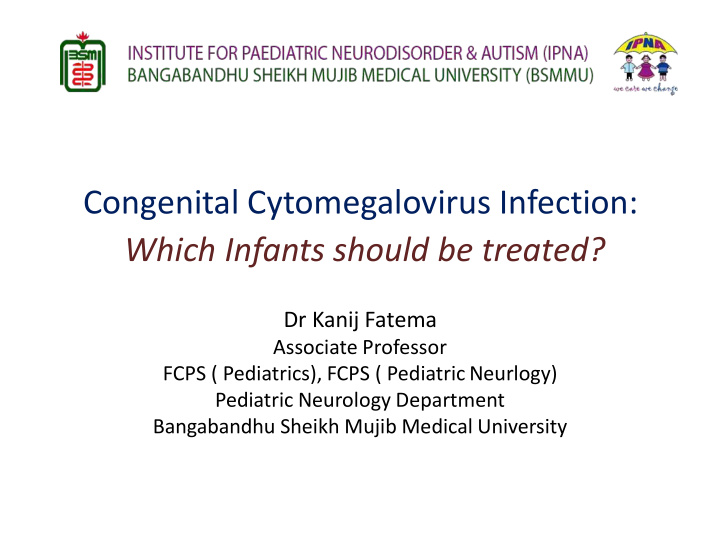



Congenital Cytomegalovirus Infection: Which Infants should be treated? Dr Kanij Fatema Associate Professor FCPS ( Pediatrics), FCPS ( Pediatric Neurlogy) Pediatric Neurology Department Bangabandhu Sheikh Mujib Medical University
Questions to be addressed 1. What is the extent of the problem in neonates? 2. When do we suspect? 3. How to confirm the diagnosis? 4. Which infants should be treated? 5. What are the treatment options?
1. What is the extent of the problem in neonates? • Incidence of cCMV infection ranges from 0.2% to 2.2% (average 1%) of all live births • Most common causes of serious congenital malformation • It is associated with developmental delay, sensorineural hearing loss (SNHL) and fetal death • Leading cause of hearing impairment in children
Global Burden of cCMV
The CMV virus causes microcephaly in babies, and it’s much more widespread than Zika
2. When do we suspect? • Only 10 – 15% have clinically apparent disease at birth (‘symptomatic’ neonates) • Intrauterine growth restriction • Petechiae • Jaundice • Hepatosplenomegaly • Microcephaly • Chorioretinitis • Sensorineural hearing loss • Neonatal seizure • Neonatal encephalopathy
• These symptomatic infants are at increased risk of developing permanent sequlae, most commonly SNHL Neurodevelopmental disorder Epilepsy Cerebral palsy Intellectual disability Visual impairment
3. How to confirm the diagnosis? • Eye evaluation • Universal Neonatal Hearing Screening • Neuroimaging • Immunoglobulin (IgM, IgG) • IgG avidity test • Polymerase chain reaction (PCR) for CMV virus (serum/urine/saliva) • Culture of virus in urine or saliva
• Universal Neonatal Hearing Screening • Neuroimaging • Eye evaluation
• Antibody titers ( IgM , IgG) • Cannot reliably make the diagnosis maternal CMV IgG crosses the placenta neonates mount weak IgM responses, only 70% with congenital CMV have IgM positive o Sensitivity of IgM CMV ELISA in relation to viral culture was 63.2% and the specificity was 85% Ref: Mediterr J Hematol Infect Dis 2013
PCR for CMV DNA quantitive assay • Specimen: saliva /urine ( or both) • High sensitivity (>97%) and specificity (99%) • Saliva sample should be collected at least 1 hour after breastfeeding to avoid potential contamination • Cost : 4000-5000 tk Ref: Lancet Infect disease 2017
• Urine or saliva culture within the first 3 weeks of life : Gold standard • This method is Expensive and laborious Results may be delayed several days Not available in most of the countries Ref : The Journal of Infectious Diseases, 2014
IgG avidity test: • Low avidity IgG indicates acute or recent primary infection • High avidity IgG indicates past infection • Not available in most of the countries Ref: Clin Diag Lab Immunol 2004
The consensus recommendations were that the diagnosis of cCMV infection in neonates should include realtime PCR of saliva, urine, or both, as soon as possible after birth but within the 1 st 3 weeks of life, with saliva as the preferred sample (level 2b evidence). Ref: Lancet infectious disease, 2017
4. Which infants should be treated ? • All CMV positive infants ? • Only symptomatic infants ? • Symptomatic and aysymptomatic infants? • Infants having hearing impairment? • Age limit ?
Which infants should be treated? • Who to treat? Neonates with moderately to severely symptomatic congenital cytomegalovirus disease • When to treat Within the first month of life Ref: Lancet infectious disease, 2017
Which infants should be treated? • Positive CMV DNA PCR Plus 1.Evidence of central nervous system involvement, including SNHL and developmental delay, other stigmata of CMV disease, even after neonatal period in infancy 2. Chorioretinitis 3. Critically ill preterm infant with life threatening CMV infection manifested by pneumonitis, hepatitis or encephalitis Ref : Arch Dis child 2014
• Asymptomatic neonates : treatment not recommended
6. What are the treatment options? Different treatment regimen : Ganciclovir for 3 weeks Ganciclovir for 6 weeks Valganciclovir for 6 weeks Valganciclovir for 6 months Ganciclovir for 6 weeks followed by oral Valganciclovir for a total duration of up to 1 year Important side effects: neutropenia, pancytopenia, infection, phlebitis, renal impairment
Current recommendation • Valganciclovir 16mg/kg/dose 12 hourly for 6 months Ref: Lancet Infect disease 2017 • Ganciclovir 6 mg/kg/dose 12 hourly for 6 weeks Ref: Arch Dis Child June 2014
Follow up • Absolute neutrophil counts should be followed weekly for 6 weeks, then at week 8, then monthly for the duration of therapy • Liver function test and renal function test should be followed monthly throughout therapy
Bangladesh study • Infants under 1 year of age • Only symptomatic infants • Urinary CMV PCR positive • Ganciclovir for 6 weeks : case ( 41-11)=30 • Valganciclovir for 6 weeks : control (37-7)= 30
95% 90% 85% Ganciclov 80% Valganci 75% 70% clearance
• No statistical difference was observed in two group at baseline and at 6 month follow up in visual and hearing assessment • However, valganciclovir treated infants had significantly improved psychological status after treatment . ( p< 0.5)
Adverse effects of drugs 70 60 50 40 30 valgancicl 20 ganciclovir 10 0 P= 0.039
Take home message 1. Suspicion of infection is necessary for early identification 2. Urinary CMV PCR quantitive assay is the preferred test to diagnose 3. Most reviews suggest to treat only neonate before 3 weeks of age 4. Valganciclovir for 6 months or ganciclovir for 6 weeks are preferred treatment
Recommend
More recommend